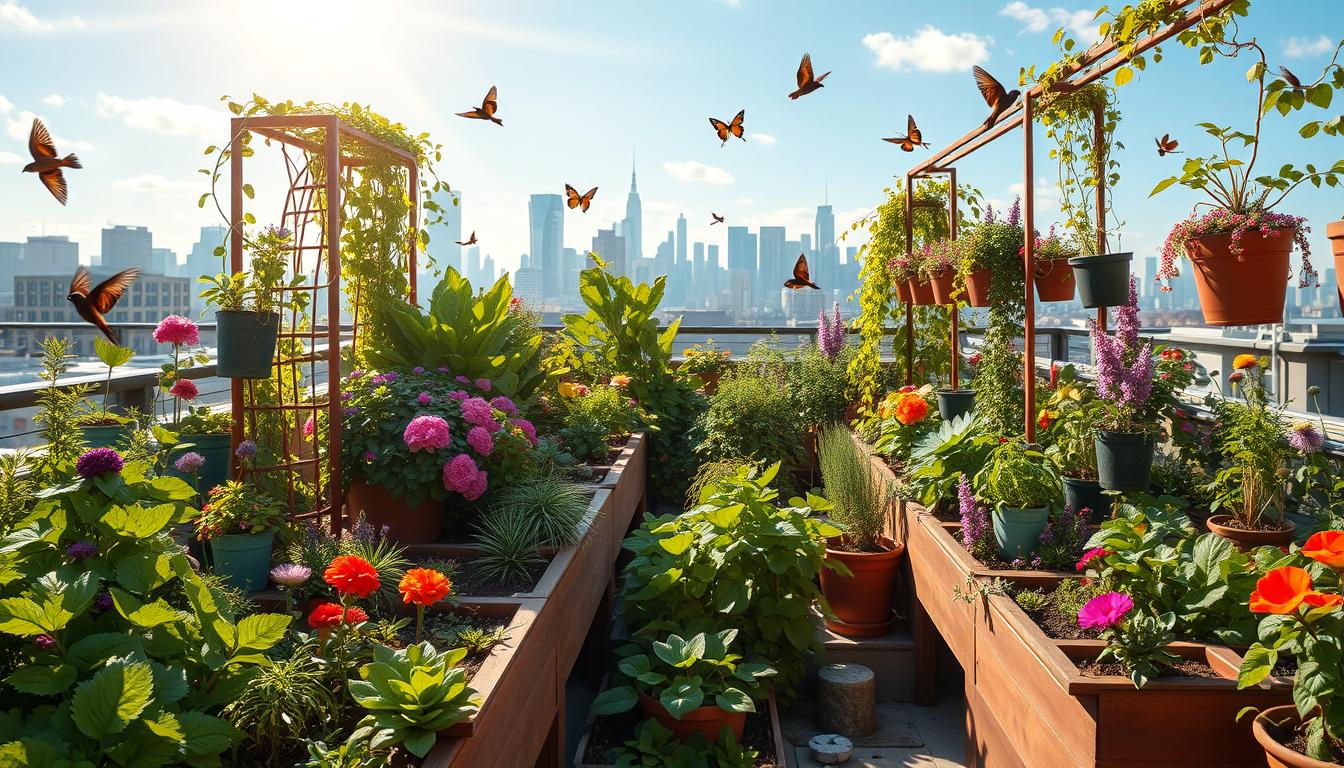I’m excited to share my passion for rooftop gardening with you! Cities are getting denser, and people are looking up for green spaces. Rooftop gardening is turning our concrete jungles into lush, productive oases.
In this guide, I’ll show you the basics of urban agriculture on rooftops. Rooftop gardens improve air quality and let you grow your own food. Whether you’re an experienced gardener or just starting, you’ll find useful tips to create your own sky-high Eden.
Get ready to see how rooftop gardening can change your urban living. Let’s explore the world of green roofs and sky gardens together!
Why Rooftop Gardening is Beneficial for Urban Dwellers
Rooftop gardening lets city folks turn unused spaces into green havens. As someone who grows plants on rooftops, I’ve found many benefits. Let’s look at why green roofs are great for city living.
Enhancing Air Quality
Green roofs clean the air in cities. Plants take in carbon dioxide and give out oxygen. They also catch pollutants, making the air cleaner around our homes.
Maximizing Space in Small Areas
In cities, using space wisely is key. Rooftop gardens make the most of overlooked spots. Even small rooftops can grow a variety of plants, from herbs to veggies.
Providing Fresh Produce
One of the best things about rooftop gardening is getting fresh food right from your roof. I love picking herbs or tomatoes for dinner. It’s a special way to connect with our food.
| Benefit | Impact |
|---|---|
| Air Quality | Reduced pollution, increased oxygen |
| Space Utilization | Efficient use of unused rooftop areas |
| Fresh Produce | Access to homegrown fruits, vegetables, and herbs |
Rooftop gardening is good for our health and the planet. It gives us cleaner air, uses space well, and provides fresh food. It’s a win for everyone.
Selecting the Right Container for Your Roof
Choosing the perfect container is key to successful rooftop gardening. The right choice can make or break your urban oasis. Let’s explore the best options for your sky-high garden.
Material Choices: What Works Best?
Material matters in container gardening. I prefer lightweight options like plastic or fiberglass for easy handling. Terracotta looks great but can be heavy and prone to cracking in freeze-thaw cycles. Metal containers are durable but can heat up quickly, potentially damaging roots.
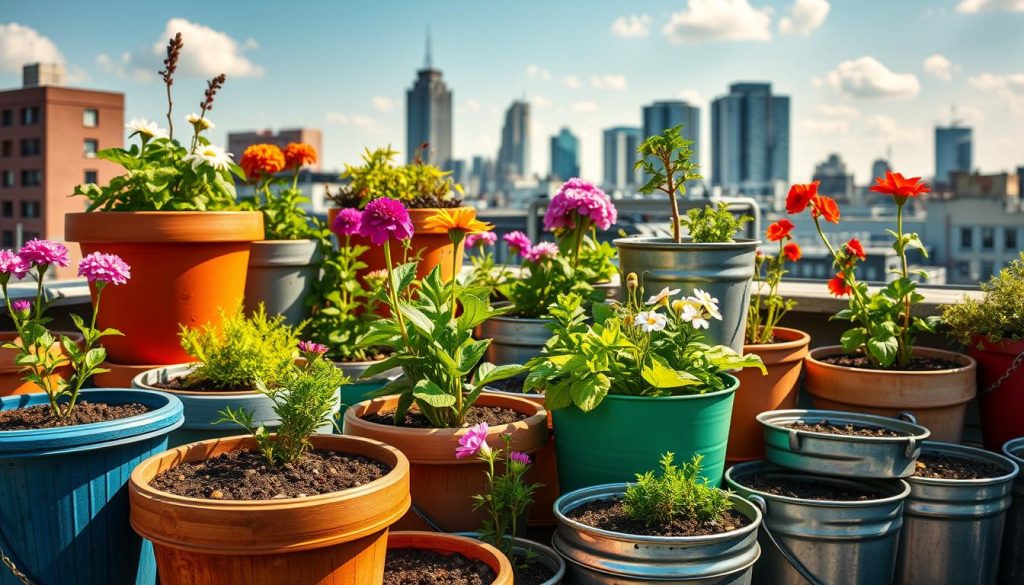
Size Matters: Choosing the Right Dimensions
The size of your containers impacts plant health and productivity. I always go for larger pots – they retain moisture better and give roots room to grow. For most vegetables, I use containers at least 12 inches deep. Herbs can thrive in shallower pots, while tomatoes need deeper ones.
Drainage Solutions to Keep Plants Healthy
Proper drainage is crucial for soil preparation and plant health. I drill extra holes in containers if needed. To prevent soil loss, I place a layer of landscape fabric over the drainage holes. For added drainage, I mix perlite or coarse sand into my potting mix. This helps avoid waterlogged roots, a common issue in container gardening.
| Container Type | Pros | Cons |
|---|---|---|
| Plastic | Lightweight, affordable | Can degrade in sunlight |
| Terracotta | Attractive, porous | Heavy, breakable |
| Metal | Durable, modern look | Can overheat |
Choosing the Best Plants for Rooftop Gardens
Choosing the right plants for your rooftop garden is crucial for sustainable living. I’ll help you pick the best plants to make your urban oasis flourish.
Herbs, Vegetables, and Flowers: What to Grow
Rooftop gardens are ideal for growing many types of plants. Herbs like basil, mint, and rosemary grow well in containers. Tomatoes, peppers, and leafy greens are excellent vegetables to grow.
For a splash of color, consider marigolds or petunias. These plants add vibrancy to your garden.
| Plant Type | Examples | Care Level |
|---|---|---|
| Herbs | Basil, Mint, Rosemary | Low |
| Vegetables | Tomatoes, Peppers, Lettuce | Medium |
| Flowers | Marigolds, Petunias, Sunflowers | Low to Medium |
Climate Considerations for Plant Selection
Your local climate is key in choosing plants. In hot areas, succulents are great because they resist drought. For cooler climates, pick hardy herbs and vegetables that can handle the cold.
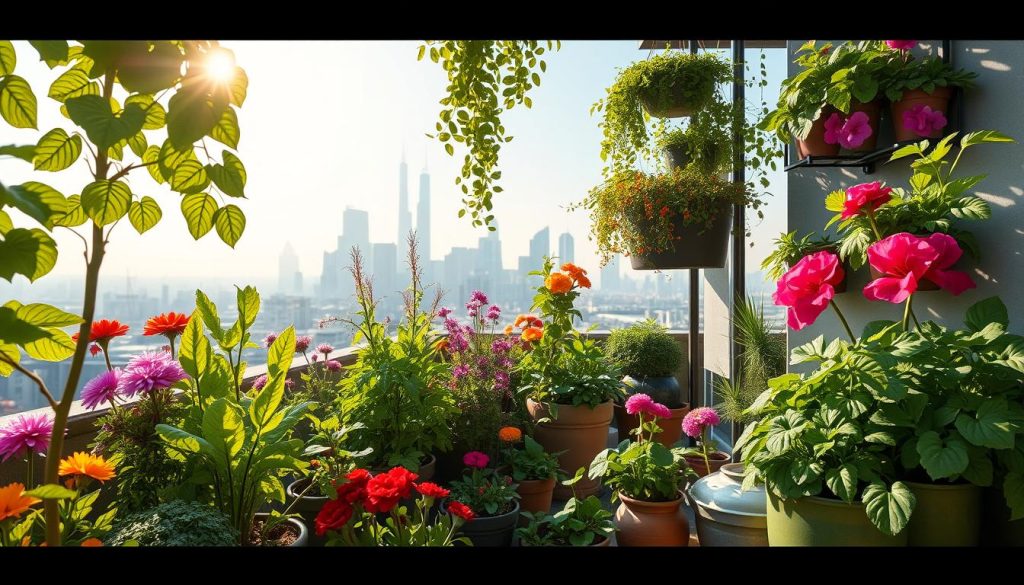
Companion Planting for Better Yields
Companion planting makes your garden healthier. Basil near tomatoes improves flavor and keeps pests away. Marigolds protect many vegetables from insects. This method boosts your garden’s productivity and supports sustainable living.
Setting Up Your Rooftop Garden: A Step-by-Step Guide
Ready to turn your rooftop into a lush garden oasis? I’ll guide you through the steps, from planning to planting. Let’s start creating your urban green space!
Plan Your Garden Layout
Begin by mapping out your rooftop. Think about sunlight and wind patterns. I use graph paper to sketch my layout.
Place taller plants on the north side to avoid shading smaller ones. Remember to include paths for easy access!
Creating a Soil Mixture for Rooftop Growth
Soil preparation is crucial for rooftop gardens. I mix:
- 1 part compost
- 1 part peat moss
- 1 part perlite
This mix holds moisture but drains well. It’s also lightweight, which is important for rooftop gardens.
Watering Systems: Manual vs. Automatic
Choosing the right irrigation system is key. Here’s a comparison:
| Manual Watering | Automatic Irrigation |
|---|---|
| More hands-on | Set-and-forget |
| Better for small gardens | Ideal for larger spaces |
| Cheaper upfront | Higher initial cost |
| Allows close plant monitoring | Consistent watering schedule |
I choose automatic drip irrigation for my rooftop garden. It saves time and ensures my plants get consistent water, even when I’m busy or away.
Managing Roof Load and Safety Precautions
Safety is crucial in rooftop gardening and urban agriculture. As an experienced gardener, I’ve learned about weight limits, wind protection, and local rules.
Understanding Weight Limits of Your Rooftop
Before starting your rooftop garden, know your roof’s weight limit. I always talk to a structural engineer for this info. They help me plan my garden layout safely.
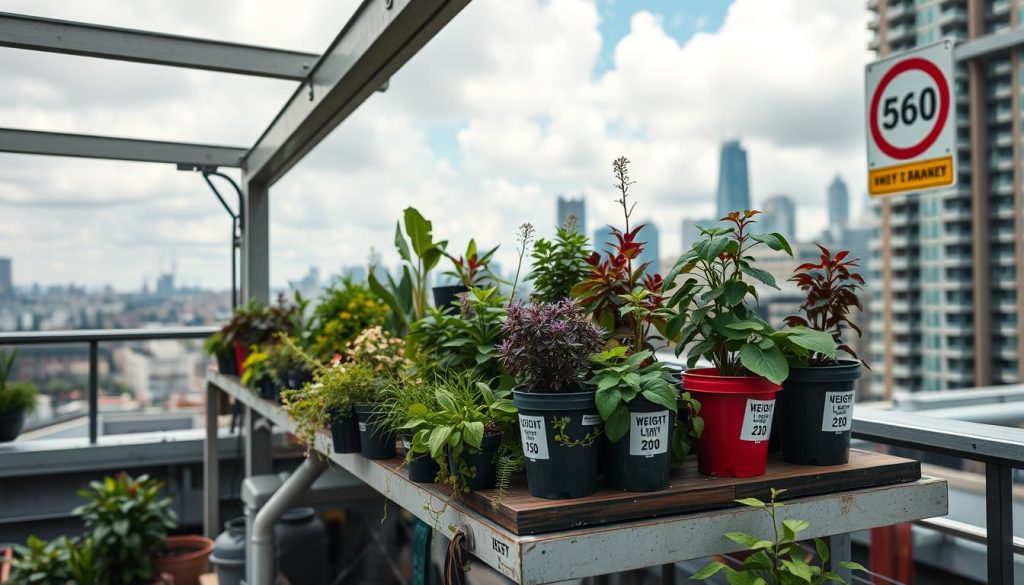
Securing Containers Against Wind
Wind can be tough on rooftop gardens. I use heavy-duty containers and tie them down. Trellises or screens help protect my garden from strong winds.
Checking Local Regulations and Building Codes
Every city has its own rooftop garden rules. I always check with my local building department before starting. They tell me about permits, height limits, and safety rules for urban gardens.
| Safety Aspect | Why It’s Important | How to Address It |
|---|---|---|
| Weight Limits | Prevents structural damage | Consult a structural engineer |
| Wind Protection | Keeps plants and containers secure | Use heavy containers and windbreaks |
| Local Regulations | Ensures legal compliance | Check with local building department |
By focusing on these safety points, you can have a great rooftop garden. It’s safe for your building and neighbors. A well-planned garden is a successful one!
Essential Tools for Successful Rooftop Gardening
As an urban grower, I’ve learned that having the right tools is key to successful container gardening. Let’s explore the essentials you’ll need for your rooftop garden.
Must-Have Tools for Urban Growers
I always keep these tools handy for my container gardening projects:
- Hand trowel for planting and transplanting
- Pruning shears for trimming plants
- Watering can or hose with adjustable nozzle
- Garden gloves to protect your hands
- Small rake for soil preparation
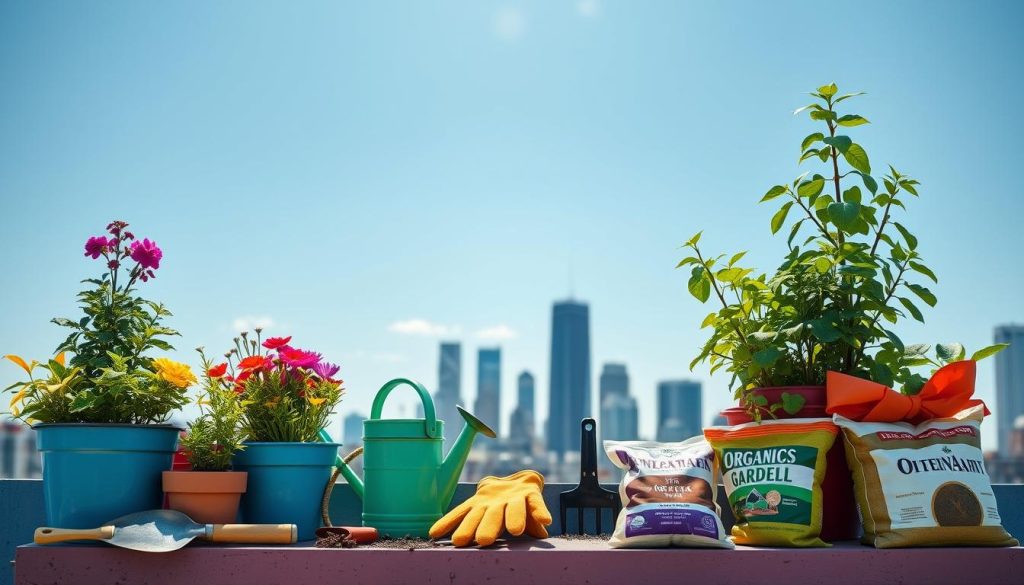
How to Organize Your Gardening Supplies
Space optimization is crucial in rooftop gardens. I use vertical storage solutions like wall-mounted shelves and hanging baskets to keep my tools organized. A small potting bench with drawers helps me store soil, fertilizers, and smaller items neatly.
Where to Buy Quality Gardening Tools
I’ve found great tools at local nurseries and garden centers. For a wider selection, online retailers like Amazon and Home Depot offer quality options. Don’t forget to check out specialty gardening websites for unique tools designed for container gardening in small spaces.
Remember, investing in good tools will make your rooftop gardening experience more enjoyable and productive. Happy gardening!
Maintaining Your Rooftop Garden Throughout the Seasons
Keeping your rooftop garden alive all year needs some work, but it’s rewarding. I’ll give you tips on plant care, pest control, and winter prep. These tips support sustainable living and make gardening in the city easy.
Seasonal Plant Care Tips
Spring is the time to plant. I start seeds indoors and move them outside when it’s warm. In summer, I water more and use mulch to keep moisture in. Fall is for picking crops and planting ones that can handle cold. Winter means protecting plants from frost and planning for next year.
Pest Control in Urban Environments
Dealing with pests in cities can be hard, but there are green ways to fight them. I use plants to keep pests away. For example, marigolds keep aphids off, and basil guards tomatoes. For tough bugs, I make a plant-safe soap spray.
Preparing Your Garden for Winter
To prepare for winter, I clean up dead plants and add compost to the soil. I move tender plants inside or use cold frames to shield them. For perennials, I cover their roots with mulch. These steps help my garden come back strong in spring.
- Clean up garden debris
- Add compost to soil
- Protect plants from frost
- Plan for next growing season
Integrating Sustainable Practices in Rooftop Gardening
Rooftop gardening is a great way to live sustainably in cities. By using eco-friendly methods, we can make green spaces that help us and the planet.
Composting and Recycling Organic Waste
Composting is a top way to cut down waste and feed your garden. I use a small bin to turn kitchen scraps into soil. It boosts plant growth and cuts down on fertilizer needs.
Collecting Rainwater for Irrigation
Having a rainwater collection system changes rooftop gardening. I set up a barrel system to catch rainwater. It saves water, cuts down on bills, and is good for the planet.
| Rainwater Collection Method | Advantages | Challenges |
|---|---|---|
| Rain Barrel | Easy to install, affordable | Limited capacity |
| Cistern | Large capacity, can supply multiple gardens | More expensive, requires more space |
| Rain Chain | Decorative, directs water flow | Less efficient for large gardens |
Encouraging Beneficial Insects in Your Garden
Having a diverse rooftop ecosystem is key for sustainable gardening. I plant flowers that attract pollinators and beneficial insects. This natural pest control method reduces harmful chemicals and makes for a healthier garden.
By using these sustainable practices, I’ve made a rooftop oasis that’s beautiful and eco-friendly. It’s fulfilling to see how these small steps can greatly impact urban sustainable living.
Dealing with Common Rooftop Gardening Challenges
Rooftop gardening can be tricky, but I’ve learned some tricks to overcome common obstacles. Let me share my experiences in creating a thriving green roof garden.
Navigating Limited Sunlight
My rooftop doesn’t get full sun all day. I’ve found success by choosing shade-tolerant plants like ferns and hostas for darker spots. For areas with more light, I use reflective surfaces to bounce sunlight onto my plants, maximizing their exposure.
Managing Temperature Fluctuations
Rooftops can get hot! I use light-colored containers to reflect heat and mulch to keep soil cool. In winter, I group plants together and use frost cloths for protection. These simple steps help my green roof garden thrive year-round.
Addressing Pest Issues without Chemicals
Pest control on a green roof doesn’t have to mean harsh chemicals. I’ve had great results with companion planting. Marigolds keep aphids away from my veggies, while basil deters flies and mosquitoes. For larger pests, physical barriers like netting work wonders. These natural methods keep my rooftop garden healthy and eco-friendly.
By tackling these challenges head-on, I’ve created a beautiful and productive green roof garden. With a bit of creativity and patience, you can too!
Community Engagement: Sharing Your Rooftop Garden Experience
Rooftop gardening is more than just growing plants. It’s about making connections. Sharing my rooftop gardening tips has connected me with many who love green cities.
Joining Urban Gardening Groups
Being part of urban gardening groups is great. We swap ideas and get advice. I’ve learned a lot about wind, space, and veggies from others.
These groups also organize garden tours. It’s a great way to get inspired.
Hosting Workshops or Plant Swaps
Hosting workshops on my rooftop is fun. I teach neighbors about composting and container gardening. We even make herb-infused oils.
Plant swaps are another fun activity. I trade my tomato seedlings for peppers or flowers.
Encouraging Neighbors to Get Involved
Getting neighbors to garden has been rewarding. A few have started their own gardens. Now, our building is a green community.
We share harvests and solve problems together. We even have rooftop potlucks. It’s amazing how gardening can change a space.

